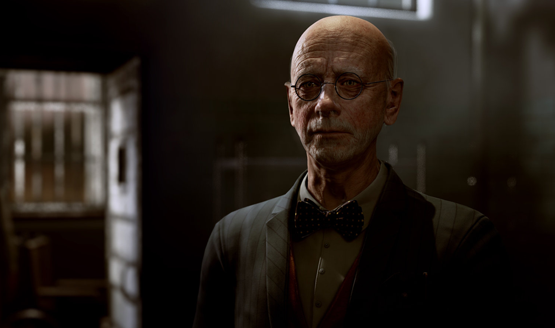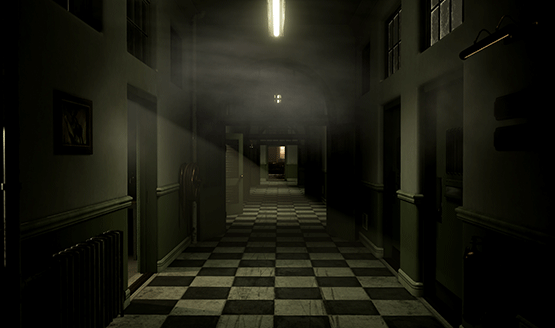Set 60 years before a night of terror befell eight teens on a snowy mountain, The Inpatient explores the history of Blackwood Sanatorium and how it came to be the backdrop for some of Until Dawn’s most intense moments. The release of The Inpatient effectively makes Until Dawn a trilogy of sorts, and perhaps one of the most bizarre trilogies in the history of games. One is a choice-based horror movie mashup that is essentially a playable teen horror flick. Rush of Blood is a strange PlayStation VR gallery shooter trip into the mind of one of the characters in Until Dawn, with a direct connection to the ending of the first game. The Inpatient is the PSVR prequel that sets the stage.
One of the downsides to prequels is that you largely know how it’s all going to end. Some enjoyment can come in the form of shifting expectations and casting previous material in a new light based on previously unrevealed information, but The Inpatient seems to stick to the established narrative. There are some surprises, mostly revolving around the immediate story being told, but don’t expect major new revelations that will change the way you look at Until Dawn’s overall story. Having played Until Dawn before The Inpatient, I found much of the story more rewarding as I came across familiar places and pieced the puzzle together, but it also made for a rather anticlimactic ending. On the other side, those who didn’t play Until Dawn may find the story a bit more confusing, but the conclusion might be more interesting.
Or that could have all been due to the particular endings that I got. I played through the game twice, each time getting different endings with different characters surviving the ordeal, but neither making it really clear why the events in the conclusion occurred. Finishing the game allowed me to look at my butterfly effect choices for the playthrough, but some seemed so obtuse that I wasn’t sure how I had done that. It also seems like some consequences don’t simply stem from the dialogue, but also in where you go or how long you wait to do something in certain situations. After my first playthrough, I was a bit annoyed by the obscure things that could potentially lead to life or death scenarios, but by the second time the credits rolled, I appreciated it more.
Locked in a Padded Room
Remember that The Inpatient is virtual reality. VR means immersion, and immersion is about forgetting that this is a game. Games use mechanics and defined rules, and normally, I’d be up in arms about a game not clearly establishing, defining, or following a clear set of rules for the game world. Obviously, on the back end there are a series of rules that define how to navigate The Inpatient’s branching narrative, but the magician hiding his secrets from the player effectively immerses them in the illusion, something that’s even more important in VR. In fact, over-reliance on mechanical branching of the story is one part I didn’t like about Until Dawn. It became too easy to see behind that curtain after multiple playthroughs. Many of the “choices” weren’t actually choices at all. I haven’t yet felt that same disappointing peek at The Inpatient’s inner workings, each time being delightfully surprised by what will or won’t impact the story being played out.
If you want the fully immersive experience, I recommend playing with two Move controllers and using voice commands to respond to each of the choice scenarios. The Inpatient models the player character’s body (and actually asks at the start if the player is male or female so that the in-game inpatient can be modeled appropriately). Using the Move controllers moves the hands in the game realistically–as long as they aren’t restrained in a wheelchair–and that simple point of reference can really pull players into the game world. Add to that the ability to speak the responses instead of pushing a button to select them, and suddenly I became the inpatient. It’s a psychological trick that does wonders for transporting me into my little room inside of Blackwood Sanatorium.
Traditional horror games have multiple tricks of their own to pull agency from the player, force perspective, and otherwise distribute the scares. Virtual reality relies on a sense of player freedom and control, so the scares have to be adjusted with that in mind. Without revealing too much, I’ll say that much of the horror in The Inpatient is built on atmosphere and leans on the player’s instinctive curiosity. The freedom of where to shine that flashlight beam, which doorway to walk through, and which hall to look down will all play a part. Just like Until Dawn, The Inpatient manages to scratch a few different horror movie itches, though it doesn’t become quite the genre hybrid that the flagship title does.
Choices and Consequences
That being said, I was disappointed as the first two-thirds led to a ton of tension build up, only to fall completely flat in both of my anticlimactic finishes. The Inpatient derives one of its biggest plot points from another popular first-person horror game (which I won’t name here, to attempt to maintain some semblance of surprise), and another beat is known to anyone who played Until Dawn. The conclusion to The Inpatient wasn’t one that left me with my mouth agape, thinking about it hours and hours afterward. It’s hard to rate a story when it’s choice driven, but the payoff has yet to completely satisfy the horror and mystery that was built up in the early parts of the game.
Run time is roughly two hours, though your mileage may vary. Different story points could potentially cut that short, but unless there’s some huge story path that I missed, I can’t see The Inpatient taking more than two or three hours to finish each time. I’m beginning to prefer the bite-sized VR experiences to those that go on for hours and hours, particularly if these smaller experiences offer replay value. Fortunately, The Inpatient begs to be played again and again, and while one playthrough may only keep me busy for a couple of hours, finding all of the collectibles, story branches, and getting the Platinum trophy will undoubtedly boost that number quite a bit.
The Inpatient is one of PSVR’s best. It’s a shining example of presence and engagement. The visuals impress and it uses a ton of clever tricks to fully immerse the player in the experience of living out Blackwood Sanatorium’s final days, making me feel like I was actually there. There are fun Easter eggs for those who have played Until Dawn, but The Inpatient can still be enjoyed without. The overall plot does fall flat in the final act as the scares give way to a less-than-exciting conclusion, but the branching possibilities means that even after two playthroughs, untold stories of the sanatorium still await me.
The Inpatient review code provided by publisher. Version 1.01 reviewed on Standard PS4. For more information on scoring, please read our Review Policy.
-
Voice commands for responses
-
A visual treat in VR
-
That horror atmosphere
-
Shape the story in your words and actions
-
Final act can fail to build on previous tension and terror
-
Can sometimes be unclear what actions are impacting the story












